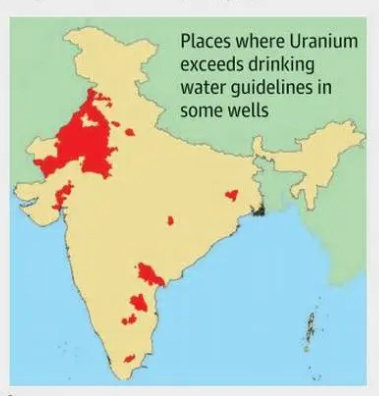- Courses
- GS Full Course 1 Year
- GS Full Course 2 Year
- GS Full Course 3 Year
- GS Full Course Till Selection
- Online Program
- GS Recorded Course
- NCERT (Recorded 500+ Hours)
- Polity Recorded Course
- Geography Recorded Course
- Economy Recorded Course
- AMAC Recorded Course
- Modern India, Post Independence & World History
- Environment Recoded Course
- Governance Recoded Course
- Science & Tech. Recoded Course
- International Relations and Internal Security Recorded Course
- Disaster Management Module Course
- Ethics Recoded Course
- Essay Recoded Course
- Current Affairs Recoded Course
- CSAT
- 5 LAYERED ARJUNA Mentorship
- Public Administration Optional
- ABOUT US
- OUR TOPPERS
- TEST SERIES
- FREE STUDY MATERIAL
- VIDEOS
- CONTACT US
Uranium contamination of Groundwater
Uranium contamination of Groundwater

Uranium contamination of Groundwater
Why in News?
Recently, the “Groundwater yearbook 2021-2022” was released by the Central Ground Water Board (CGWB).
What is Uranium?
- It is a naturally occurring element found in low levels within all rock, soil, and water.
- Uranium is a weak radioactive substance because of its long physical half-life.
- It is the highest-numbered element to be found naturally in significant quantities on earth.
- Uranium is a nephrotoxic element, means it can have an adverse impact at very high concentrations.
How does uranium enter ground water?
- The mechanism by which uranium enters groundwater is still under research.
- 2 types of terrains have been identified with heavy contamination, namely:
- Alluvial aquifers in Rajasthan
- North-western regions
- Some researchers have imagined that over-extraction of ground water exposes uranium to air, which triggers its release from the rocks.
- Further research is needed in this regard as it would help in identifying regions where safer water can be found.
- Notably, even information of how uranium accumulated with the rocks (during sedimentation), would help in estimating the regions of prevalence.
What are the health effects?
- Preliminary studies on the health effects of drinking uranium-tainted water among animals and humans have revealed that it causes kidney damage.
- Notably, this is said to be caused by the chemical effect of uranium, rather than a radiological, even though uranium is radioactive.
- Nonetheless, we need more comprehensive systematic studies to establish the chronic health effects of uranium exposure.
What are the major Findings?
- 12 Indian states have uranium levels beyond permissible limits in their groundwater.
- Punjab is the worst-affected state in terms of the percentage of wells found to have uranium concentration of more than 30 ppb.
- Haryana is the second state in terms of uranium prevalence in groundwater.
- 9.2% of the samples from Uttar Pradesh had a high concentration of uranium.
- Uranium concentration is found to be within safe limits in 13 states.
- The safe levels prescribed by the Bureau of Indian Standards (BIS) and the World Health Organization (WHO) is 30 ppb.
|
State |
Maximum value of Uranium observed (In ppb) |
Percentage of samples beyond permissible limit of BIS (U >30 ppb) |
|
Punjab |
532 |
29 |
|
Haryana |
518 |
14.4 |
|
Uttar Pradesh |
239 |
9.2 |
|
Rajasthan |
186 |
8.6 |
|
Tamil Nadu |
159 |
3.4 |
|
Madhya Pradesh |
149 |
1.3 |
|
Odisha |
61.4 |
0.69 |
|
Delhi |
58.3 |
3.9 |
|
Telangana |
36.1 |
1.43 |
|
Chhattisgarh |
32 |
0.12 |
|
Bihar |
31.4 |
0.36 |
Source: Groundwater yearbook 2021-22
What are the Causes of contamination of Groundwater?
- High levels of uranium are largely due to natural uranium content in aquifer rocks, oxidation state and groundwater chemistry.
- Overexploitation of groundwater has been observed in all types of aquifers in the country, confirmed in another 2021 study by researchers from Bhabha Atomic Research Centre (BARC) and Homi Bhabha National Institute.
- Extreme bicarbonate levels were also found at the sites with high uranium levels.
[Bicarbonates help to bring the uranium out of the source rocks and is a reason for the high occurrence of the element.]
- The interaction of the extracted uranium with other chemicals in the groundwater, such as bicarbonate, which can further enhance its solubility.
- Water-rock interactions that cause the uranium to be extracted from those rocks.
- Oxidation conditions that enhance the extracted uranium’s solubility in water.
- Over-exploitation of groundwater from irrigation further exacerbates uranium mobilisation. It is likely to be one of the reasons for uranium and other geogenic contaminants, including arsenic and fluoride.
Way Ahead
- Protection of groundwater must be guaranteed across all sectors including agriculture.
- Reverse osmosis (RO) is one of the latest membrane-based technologies used in water purification systems to remove uranium.
- More studies and Research are needed on the removal of uranium from drinking water using a hybrid membrane technique.
Must Check: Best IAS Coaching Institute In Delhi


